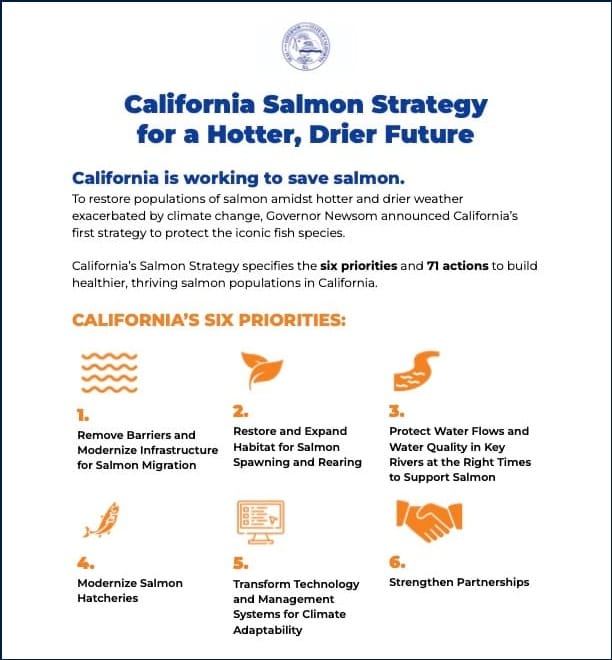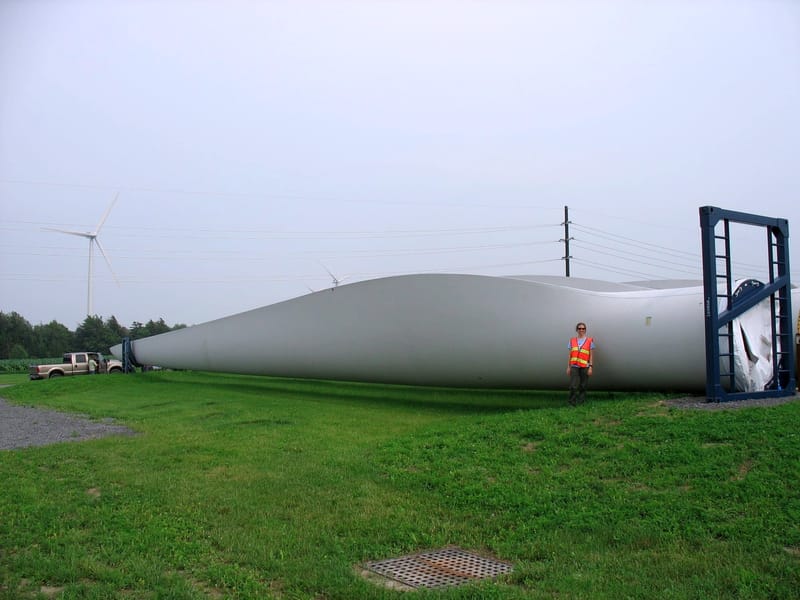What is "California’s Salmon Strategy for a Hotter, Drier Future", and how's it going?
Almost two years after unveiling a new strategy to prevent salmon extinction, California has moved from planning to action—restoring floodplains and returning ancestral lands to tribes. Here is where the ambitious plan stands as of late 2025.
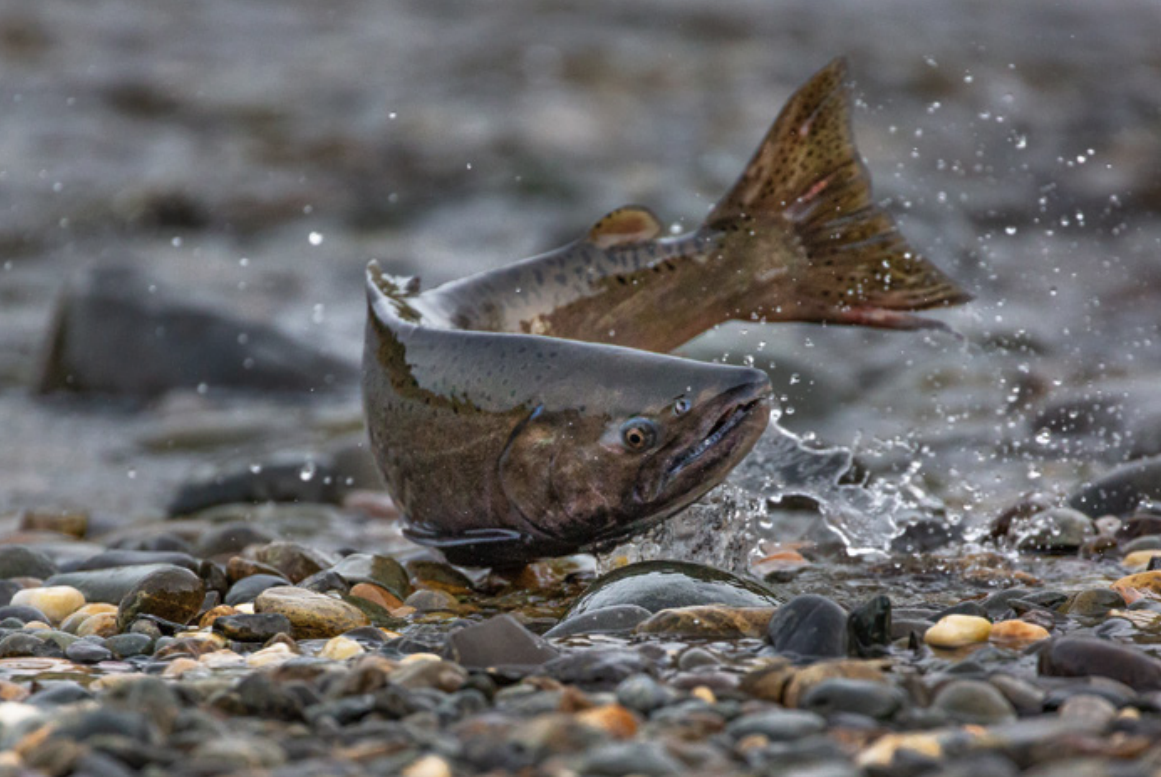
Launched early in 2024 by Governor Newsom, the California Salmon Strategy for a Hotter, Drier Future is California's official policy roadmap for preventing the extinction of native salmon. The California Department of Fish and Wildlife (CDFW) is spearheading the ongoing initiative, collaborating with tribal partners and federal agencies to implement specific, binding actions that adapt the state's water management to a rapidly warming climate.
A progress report released in March 2025 details the significant strides already made, yet the strategy remains built around a stark reality: despite the wet winters of 2023 and 2024, native salmon populations remain perilously low.
Based on the six key priorities detailed below, the strategy focuses on the four major species of salmon that still exist in California—Chinook, coho, pink, chum, and steelhead.
The plan represents a shift from passive observation to active, "all-of-government" intervention, acknowledging that without aggressive modernization of infrastructure and hatchery systems, California risks losing these native species entirely.
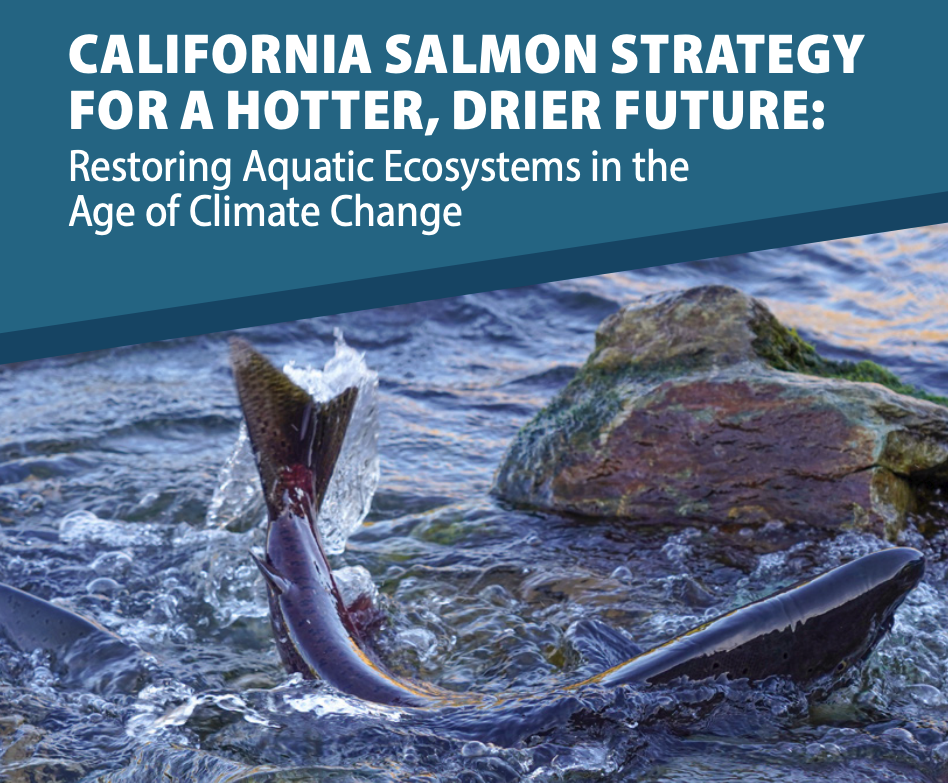
Sources & References
This article is sourced directly from the:
- California Salmon Strategy for a Hotter, Drier Future (2024): The original 37-page strategic roadmap outlining the state's policy for protecting native salmon species.
- California Salmon Strategy... March 2025 Progress Report: An official status update covering January 2024 through March 2025, detailing completed milestones such as the Klamath dam removals and updated hatchery production data.
The Stakes
The strategy argues that saving salmon is not just about preserving a single type of fish; it is about protecting a "keystone species" that holds entire ecosystems together.
Ecological "Force Multipliers": Salmon are described as nature's "force multipliers". They begin their lives in mountain streams, migrate to the ocean, and return to die in the rivers where they were born. This unique lifecycle allows them to transport vast amounts of ocean nutrients deep into upland forests and soils. Their bodies feed other wildlife and enrich the habitats they return to, meaning their health dictates the health of the broader environment.
Cultural Heritage: Salmon are central to the religions, creation stories, and subsistence of Indigenous Peoples in California. The strategy highlights that healthy salmon runs are vital for protecting these cultures and ways of life that extend back to time immemorial.
Economic Engine: Beyond their biological value, salmon historically support a multi-million-dollar commercial and recreational fishing industry. However, this economic engine has stalled in recent years. Due to critically low population counts, commercial salmon fishing off the coast of California was closed entirely in 2023, 2024, and 2025. This crisis highlights the urgent need for recovery, as many Californians rely on the fishery for their livelihood, while others depend on it for food security.
The Root Problem: Blocked Arteries
If salmon are so vital, why are they disappearing? The strategy identifies a collision between historical infrastructure and modern climate change.
The Legacy of Dams: Starting in the early 1900s, California built massive dams on almost every major river in the Central Valley. While these dams provided water and power for a growing state, they blocked salmon access to over 90% of their historical spawning and rearing habitat.
The Temperature Trap: Historically, salmon spawned in high-elevation mountain streams where the water remained cold year-round. Because dams now block access to these mountains, salmon are forced to spawn on the valley floor. In a "hotter, drier future," these lower-elevation waters are warming to lethal levels, trapping the fish in habitats that can no longer sustain them.
Climate Disruption: The strategy notes that salmon have survived climate variability for millions of years, but the current rate of change—combined with the loss of habitat—is overwhelming their natural resilience.
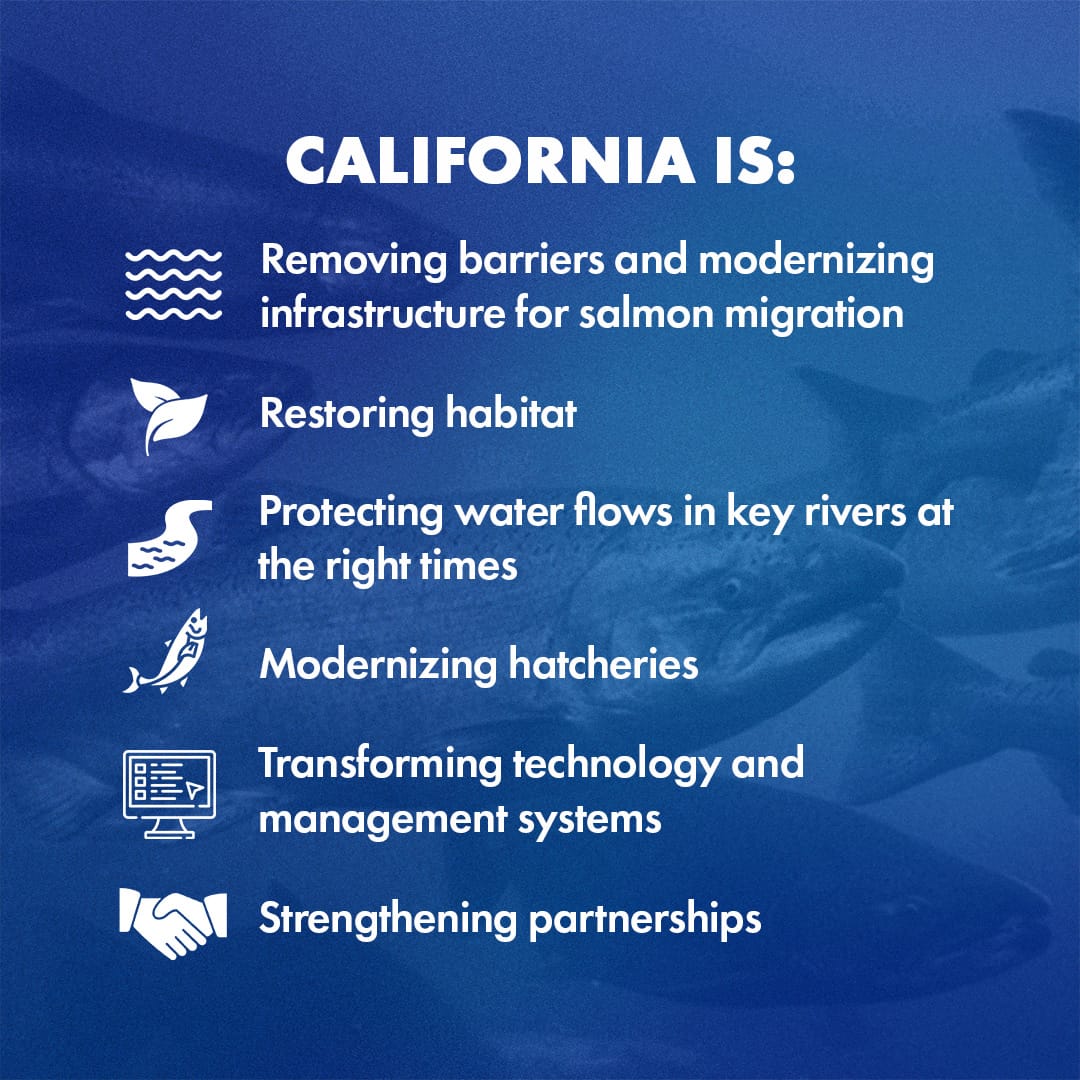
The Six Strategic Priorities
The core of California's strategy rests on six specific pillars designed to address the immediate threats of climate change and infrastructure limitations.
1. Remove Barriers and Modernize Infrastructure for Salmon Migration
For generations, California’s water infrastructure has supported agriculture and cities but has severed salmon from their natural homes. Large dams built in the early 1900s now block salmon access to over 90% of their historical spawning and rearing habitat in mountain streams. This forces fish to rely on valley floor habitats that are becoming lethally hot due to climate disruption. The state is prioritizing the removal of obsolete dams and the modernization of active ones to reconnect these vital corridors.
The Klamath River Renewal: The centerpiece of this priority is the largest river restoration project in American history. In October 2024, the removal of four dams on the Klamath River was successfully completed. For the first time in a century, the river flows freely, restoring access to over 420 miles of habitat. Salmon have already been observed returning to the upper basin, marking a major victory for the state and its tribal partners.
Coastal Dam Removals:
- Eel River: In February 2025, the state signed a historic Memorandum of Understanding (MOU) to decommission and remove the seismically unfit Scott Dam. This agreement paves the way to unblock access to 288 miles of pristine upper watershed habitat.
- Malibu Creek: Planning is underway to remove the Rindge Dam, a defunct structure filled with sediment, to open 15 miles of spawning habitat for endangered steelhead.
- Ventura River: The state plans to remove the Matilija Dam by 2030 to restore steelhead habitat and replenish local beaches with sediment.
Modernization and Passage: For dams that remain operational, the strategy focuses on physical passageways and infrastructure upgrades. This includes constructing a new fishway on the Yuba River and modernizing diversions on the Feather River to reduce entrainment risk (fish being drawn into water pumps).
2. Restore and Expand Habitat for Salmon Spawning and Rearing
Simply removing barriers is not enough; the habitat itself must be productive. Most of California's wetlands have been lost, and large rivers have been disconnected from their floodplains. Science shows salmon that spend time on reconnected floodplains grow larger and have a higher survival rate before entering the ocean.
Floodplain Reactivation: The state is making rapid progress on large-scale restoration. In September 2024, the Lookout Slough Tidal Habitat Restoration Project was completed, restoring 3,400 acres of vital tidal habitat in Solano County. Additionally, major construction has been completed on the "Big Notch Project" in the Yolo Bypass, with the system expected to be fully operational by November 2025 to inundate thousands of acres of floodplain habitat.
The "Beaver Strategy": The strategy officially enlists beavers as allies in recovery. Beaver dams create deep, cold pools that act as ideal nurseries for juvenile salmon. The state has moved from planning to action, successfully completing beaver translocations to the Tasmam Koyom and Tule River reservation by 2025. These beavers are now naturally restoring ecosystems in watersheds where they had previously been extirpated.
Streamlining Permitting: To accelerate these projects, the state is utilizing the "Cutting the Green Tape" initiative. As of 2025, this initiative has successfully permitted or cleared 49 priority salmon restoration projects for construction, significantly exceeding original targets.
3. Protect Water Flows and Water Quality
Habitat restoration fails without sufficient water. "Salmon go where water flows," and flows are critical for enticing adults to spawn and transporting juveniles to the ocean. The strategy focuses on securing cold water flows during key times, even amidst drought conditions.
Instream Flow Requirements: The State Water Resources Control Board is working to establish regulatory minimum stream flows for priority watersheds. This includes setting emergency minimum flows for salmon strongholds like the Scott and Shasta rivers while developing long-term strategies.
Groundwater Management: Recognizing that groundwater and surface water are connected, the state is enforcing the Sustainable Groundwater Management Act (SGMA) to ensure that groundwater pumping does not deplete the rivers salmon rely on.
Voluntary Agreements: The state is utilizing a mixture of regulatory pressure and financial incentives. For example, the state has executed contracts with alfalfa growers to forego groundwater pumping to keep water in the Scott River and supported a "Voluntary Water Sharing Program" in the Russian River where senior water rights holders reduced use to protect fish.
Illegal Cultivation Enforcement: The strategy includes specific actions by the Unified Cannabis Enforcement Task Force (UCETF) to target illegal cannabis grows that divert water and damage salmon streams.
While physical restoration is critical, the strategy acknowledges that modern interventions and human collaboration are equally vital to prevent extinction. The final three priorities focus on upgrading our "life support" systems for salmon, using better science, and working together.
4. Modernize Salmon Hatcheries
California’s hatchery system is one of the largest in the world, originally built to mitigate the habitat loss caused by dams. However, this infrastructure is aging and vulnerable to the same climate pressures affecting wild rivers. The strategy moves beyond "production at all costs" toward conservation-focused management.
Climate-Resilient Infrastructure: The state is conducting a top-to-bottom assessment of 22 hatcheries to identify those most at risk from warming waters. Planned upgrades include installing water chillers, insulation, and UV treatment systems to ensure eggs and fry survive heatwaves.
Production Success: While shifting toward conservation, the state also acted swiftly to mitigate immediate drought impacts. In 2024, hatcheries successfully produced an additional 12.6 million fall-run Chinook salmon, exceeding the state's original production goal
Emergency Contingencies: In years of severe drought, lethal river conditions make natural migration impossible. The strategy formalizes the use of trucking to transport millions of juvenile salmon directly to San Pablo Bay, San Francisco Bay, and seaside net pens, bypassing hot, low-flow rivers to increase survival rates.
Genetic Tracking: The state is transitioning to Parentage-Based Tagging (PBT). Instead of physically tagging a portion of fish, PBT uses genetic sampling of the parents to "tag" every single offspring genetically. This non-invasive method allows 100% of hatchery fish to be identifiable, providing vastly better data on survival and straying without handling every juvenile fish.
5. Transform Technology and Management Systems for Climate Adaptability
Management decisions in the past relied on historical averages, but in a rapidly changing climate, the past is no longer a reliable predictor of the future. The strategy calls for a shift to real-time, technology-driven management.
Real-Time Data & Monitoring: The state is investing in a network of new stream gages and advanced modeling tools. This allows water managers to make decisions based on current conditions—managing reservoir releases to maintain precise water temperatures for salmon eggs downstream.
Combating Thiamine Deficiency: Scientists recently discovered that a shift in ocean forage—specifically salmon eating too many anchovies—causes a thiamine (Vitamin B1) deficiency that kills juvenile salmon. The strategy includes treating hatchery eggs with thiamine baths to reverse this condition and conducting ongoing ocean monitoring to predict these shifts.
Modernizing Harvest Models: The strategy directs the state to update the models used to set fishing seasons. Instead of relying on static assumptions, new models will incorporate climate data to better forecast salmon abundance and prevent overfishing during vulnerable years.
6. Strengthen Partnerships
The scale of the crisis exceeds the capacity of any single agency. This strategy explicitly shifts toward a "co-management" model, recognizing that success requires the combined power of state, federal, and tribal entities.
Tribal Co-Management: A cornerstone of this priority is correcting historical exclusions by formally partnering with Tribal Nations.
- Example: The Winnemem Wintu Tribe is now a co-manager in the effort to reintroduce winter-run Chinook salmon to the McCloud River, utilizing their traditional ecological knowledge alongside western science.
- Klamath River: The removal of the Klamath dams is highlighted as a proof-of-concept for what tribal leadership and state partnership can achieve.
Land Return: In a historic step for the "Strengthening Partnerships" priority, the state has committed to supporting the return of over 2,800 acres of ancestral land to the Shasta Indian Nation as part of the post-Klamath dam removal recovery process
Collaborative Science: The strategy encourages "science collaboratives" that bring together water users, conservation groups, and agencies. This reduces conflict by ensuring everyone is working from the same agreed-upon data regarding river flows and fish health.
Business and Local Engagement: This element of the plan calls on local water districts and agricultural businesses to be active partners—not just by following regulations, but by voluntarily implementing water efficiency and habitat projects.
Critical Timeline & Targets
The California Salmon Strategy was designed with urgency in mind, establishing specific, time-sensitive benchmarks to measure the state's progress. The document sets following deadlines to avert extinction and jumpstart recovery.
Completed Milestones (2024–2025)
- Klamath River: The removal of the remaining three dams on the Klamath River was completed in October 2024.
- San Joaquin Facility: Construction of the San Joaquin Salmon Conservation and Research Facility was completed in December 2024.
- Eel River: A major MOU was signed in early 2025 to decommission the Scott Dam and replace the Cape Horn Dam.
- Beaver Reintroduction: The state successfully met its target of completing additional beaver translocation projects to restore watersheds.
- Flow Protections: Minimum instream flows were established for the Scott and Shasta Rivers.
Ongoing 2025–2026 Targets
- Bay-Delta Plan: The State Water Board released its latest updated draft of the Water Quality Control Plan for the San Francisco Bay/Sacramento-San Joaquin Delta Watershed in July 2025.
- Hatchery Transition: The transition from the Iron Gate Hatchery to the new, modern facility on Fall Creek is underway following the Klamath dam removals.
- Production Boost: Following the completion of the Salmon Conservation and Research Facility, it is ramping up operations with a 2025 production target of 250,000 spring-run Chinook salmon
- Floodplain Habitat: The state is on track to modify water infrastructure to provide seasonal inundation of at least 10,000 acres of floodplain habitat by 2026.
Long-Term Vision (2027–2030)
- Rindge Dam: Start deconstruction of the Rindge Dam on Malibu Creek no later than 2028.
- Matilija Dam: Complete final tasks to ensure the removal of the Matilija Dam in 2030 to restore steelhead habitat.
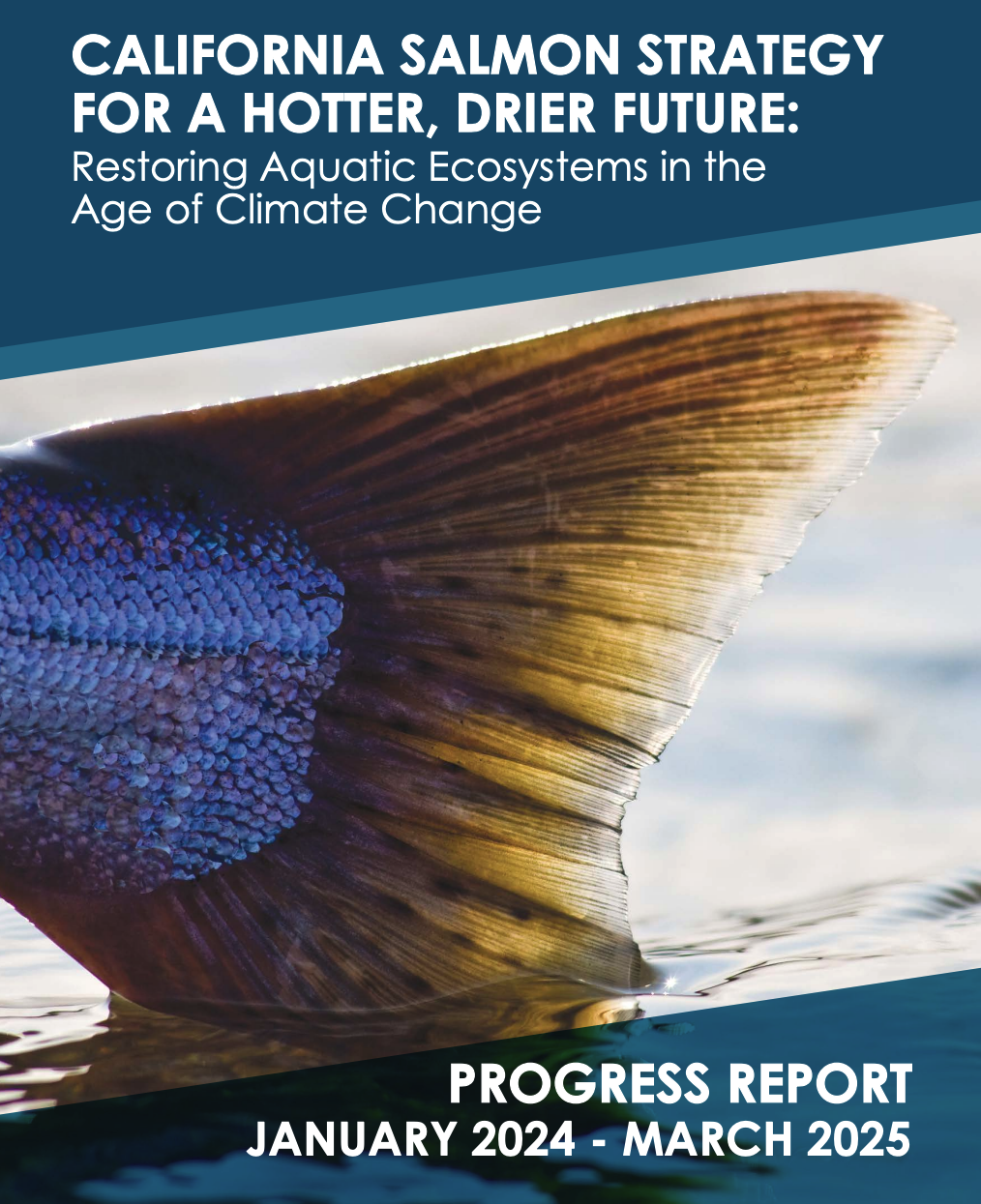
A Path to Recovery
The "California Salmon Strategy for a Hotter, Drier Future" represents a fundamental shift in how the state manages its natural resources. It moves away from a siloed approach and toward an "all-of-government" strategy that integrates infrastructure, biology, and law.
The document emphasizes that recovery is built into salmon DNA; they have endured global-scale climate variabilities for millions of years. The challenge is that human infrastructure and climate change have pushed them to the brink. By removing barriers, restoring "force multiplier" species such as beavers, and modernizing our management systems, the state aims to give salmon the fighting chance they need to recover.
Ultimately, this strategy posits that healthy salmon runs are not just about fish—they are about protecting the cultures of Indigenous Peoples, the health of our forests, and the economic vitality of California. As the strategy concludes: "The future of California salmon is up to us all".
